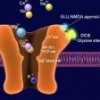I've been thinking about how activated charcoal might be working to improve longevity. It must be absorbing something bad, and since it has a big effect when started late in life, it must be something whose level climbs with age. One possibility is
Indoxyl Sulfate:
Indoxyl sulfate is a dietary protein metabolite, and also the metabolite of the common amino acid tryptophan. Indoxyl sulfate is a circulating uremic toxin stimulating glomerular sclerosis and interstitial fibrosis. Indoxyl sulfate is one of the well known substances of a group of protein-bound uremic retention solutes. Indoxyl sulfate increases the rate of progression of renal failure. In plasma, indoxyl sulfate is a protein-bound uremic solute that induces endothelial dysfunction by inhibiting endothelial proliferation and migration in vitro. Some studies suggest that indoxyl sulfate is also involved in oxidative stress. In hemodialyzed patients, serum levels of indoxyl sulfate are associated with levels of pentosidine, a marker of carbonyl and oxidative stress; in vitro, indoxyl sulfate increases reactive oxygen species (ROS) production in tubular cells, and increases NAD(P)H oxidase activity in endothelial cells. Indoxyl sulfate impairs osteoblst function and induces abnormalities of bone turnover. Indoxyl sulfate strongly decreases the levels of glutathione, one of the most active antioxidant systems of the cell. (PMID: 10681668, 14681860, 17471003, 17403109)
This stuff is really a bad actor. Its level rises as kidney function declines. Here's some information on its undesirable effects:
J Ren Nutr. 2012 Jan;22(1):102-6.
Indoxyl sulfate induces nephrovascular senescence.
Niwa T, Shimizu H.
Department of Advanced Medicine for Uremia, Nagoya University School of Medicine, Showa-ku, Nagoya, Japan. tniwa@med.nagoya-u.ac.jp
Indoxyl sulfate is markedly accumulated in the serum of chronic kidney disease (CKD) patients. The oral sorbent AST-120 reduces serum levels of indoxyl sulfate in CKD patients by adsorbing indole, a precursor of indoxyl sulfate, in the intestine. Indoxyl sulfate is taken up by proximal tubular cells through organic anion transporters (OAT1, OAT3), and it induces reactive oxygen species (ROS) with impairment of cellular antioxidative system. Indoxyl sulfate stimulates progression of CKD by increasing renal expression of profibrotic cytokines such as transforming growth factor beta 1. Further, it promotes the expression of p53 by ROS-induced activation of nuclear factor kappa B, thereby accelerating senescence of proximal tubular cells with progression of CKD. Administration of indoxyl sulfate to hypertensive rats reduces renal expression of Klotho and promotes cell senescence, with expression of senescence-associated beta-galactosidase, p53, p21, p16, and retinoblastoma protein, accompanied by kidney fibrosis. Indoxyl sulfate downregulates Klotho expression in the kidneys through production of ROS and activation of nuclear factor kappa B in proximal tubular cells. It promotes cell senescence, with expression of senescence-associated beta-galactosidase, p53, p21, p16, and retinoblastoma protein, in the aorta of hypertensive rats. It also promotes aortic calcification and aortic wall thickening in hypertensive rats with expression of osteoblast-specific proteins, induces ROS in vascular smooth muscle cells and vascular endothelial cells, stimulates proliferation and osteoblastic transdifferentiation of vascular smooth muscle cells, and inhibits viability and nitric oxide production of vascular endothelial cells. Thus, indoxyl sulfate accelerates the progression of not only CKD but also of cardiovascular disease by inducing nephrovascular cell senescence.
PMID: 22200425
Can oral activated charcoal, which is restricted to the GI tract, do anything about a systemic toxin? Apparently so:
PLoS One. 2012;7(7):e41281. Epub 2012 Jul 19.
Chronic kidney disease-induced cardiac fibrosis is ameliorated by reducing circulating levels of a non-dialysable uremic toxin, indoxyl sulfate.
Lekawanvijit S, Kompa AR, Manabe M, Wang BH, Langham RG, Nishijima F, Kelly DJ, Krum H.
Centre of Cardiovascular Research and Education in Therapeutics, Department of Epidemiology and Preventive Medicine, Monash University, Melbourne, Australia.
Cardiovascular death commonly occurs in patients with chronic kidney disease. Indoxyl sulfate (IS), a uremic toxin, has been demonstrated in vitro as a contributory factor in cardiac fibrosis, a typical pathological finding in uremic cardiomyopathy. This study aimed to determine if cardiac fibrosis is reversible by lowering serum IS levels using an oral charcoal adsorbent, AST-120. Subtotal-nephrectomized (5/6-STNx) Sprague-Dawley rats were randomized to receive either AST-120 (AST-120, n=13) or no treatment (vehicle, n=17) for 12 weeks. Sham operated rats (n=12) were used as controls. Early left ventricular (LV) diastolic dysfunction was demonstrated by an increase in peak velocity of atrial filling [A and A' waves] and a decrease of E/A and E'/A' ratios obtained by echocardiography. This was accompanied by a 4.5-fold increase in serum IS (p<0.001) as well as elevated tail-cuff blood pressure (p<0.001) and heart weight (p<0.001). Increased LV fibrosis (p<0.001), gene expression of pro-fibrotic (TGF-β, CTGF) and hypertrophic (ANP, β-MHC and α-skeletal muscle actin) markers, as well as TGF-β and phosphorylated NF-κB protein expression were observed in STNx + vehicle rats. Treatment with AST-120 reduced serum creatinine (by 54%, p<0.05) and urine total protein (by 27%, p<0.05) vs vehicle whilst having no effect on blood pressure (AST-120 = 227±11 vs vehicle = 224±8 mmHg, ns) and heart weight. The increase in serum IS was prevented with AST-120 (by 100%, p<0.001) which was accompanied by reduced LV fibrosis (68%, p<0.01) and TGF-β and phosphorylated NF-κB protein expression (back to sham levels, p<0.05) despite no significant change in LV function. In conclusion, STNx resulted in increased cardiac fibrosis and circulating IS levels. Reduction of IS with AST-120 normalizes cardiac fibrosis, in a blood pressure independent manner.
PMID: 22829936 Free full text
AST-120 is a Japanese activated charcoal product also known as Kremezin. Note that I'm not claiming indoxyl sulfate is "the answer", but it's an example of a very nasty metabolite that is reduced by oral activated charcoal. Recently there was a lot of discussion around senescent cells, which actively pump out molecules that cause a lot of damage to their surroundings. In an important paper that came out recently, it was shown that selective killing of senescent cells was able to reverse the aging phenotype. That shows the degree of damage caused not by the senescent cells themselves, but by the junk they emit. I was wondering if any of these compounds could be reduced by oral activated charcoal, but that might be a tall order, since the senescent cells are dumping those compounds into circulation. Only if they found their way into the gut would the charcoal be able to absorb them. It's possible that some of them might do that, at least to some extent. Small molecules are known to "exsorb" from circulation into the gut lumen, though generally at a low level. There are eflux pumps that actively transport certain small molecules back into the gut, and a number of compounds are excreted via the bile, some of which are later reabsorbed. Given the variety of ways a molecule could get from circulation to the gut, I couldn't rule out such compounds as being involved in the activated charcoal LE effect.
Another possiblity is exogenous (dietary) AGEs. These are highly damaging to the organism, and since they enter via the gut, the activated charcoal would be positioned to intercept them.




















































